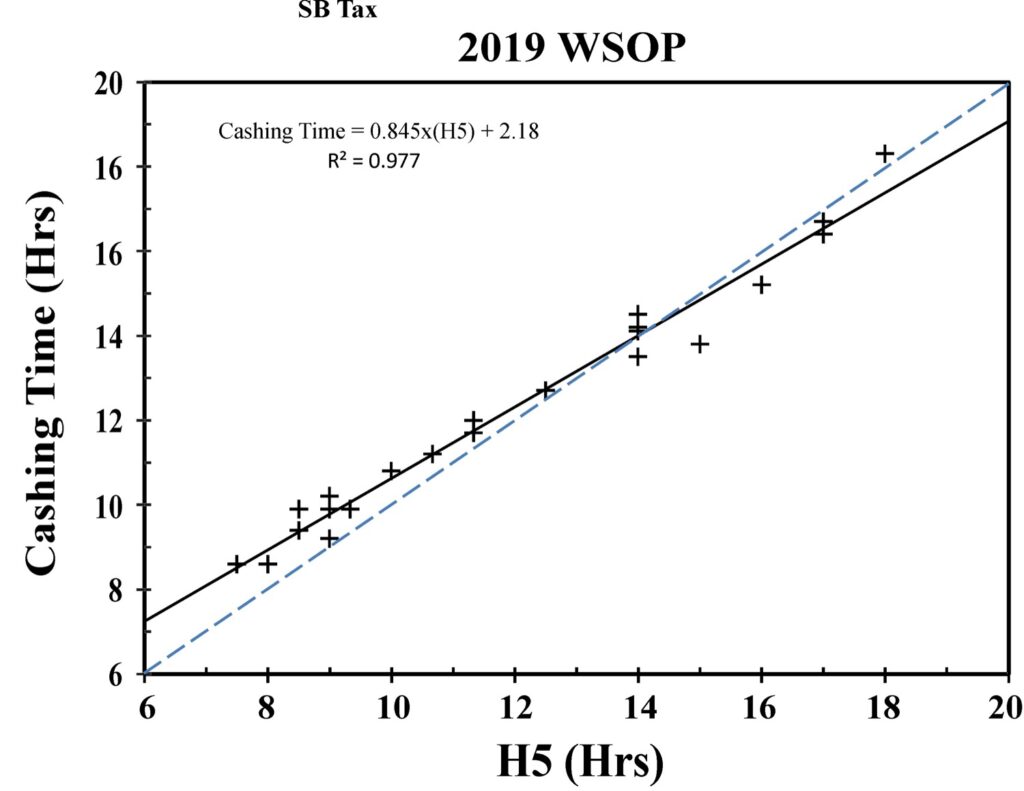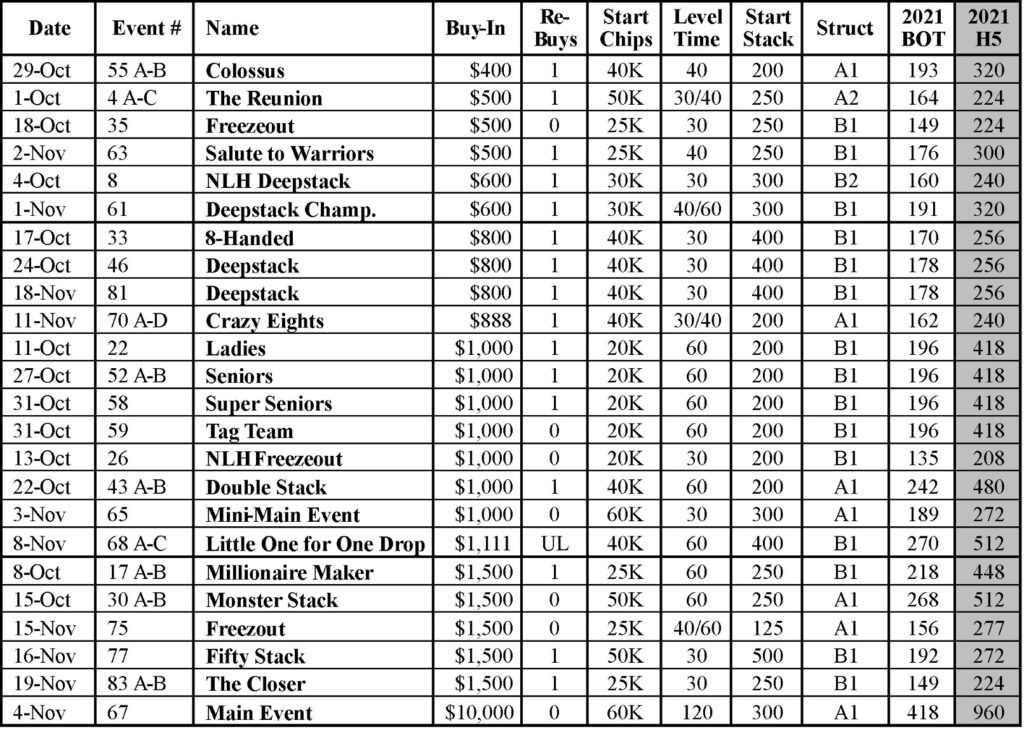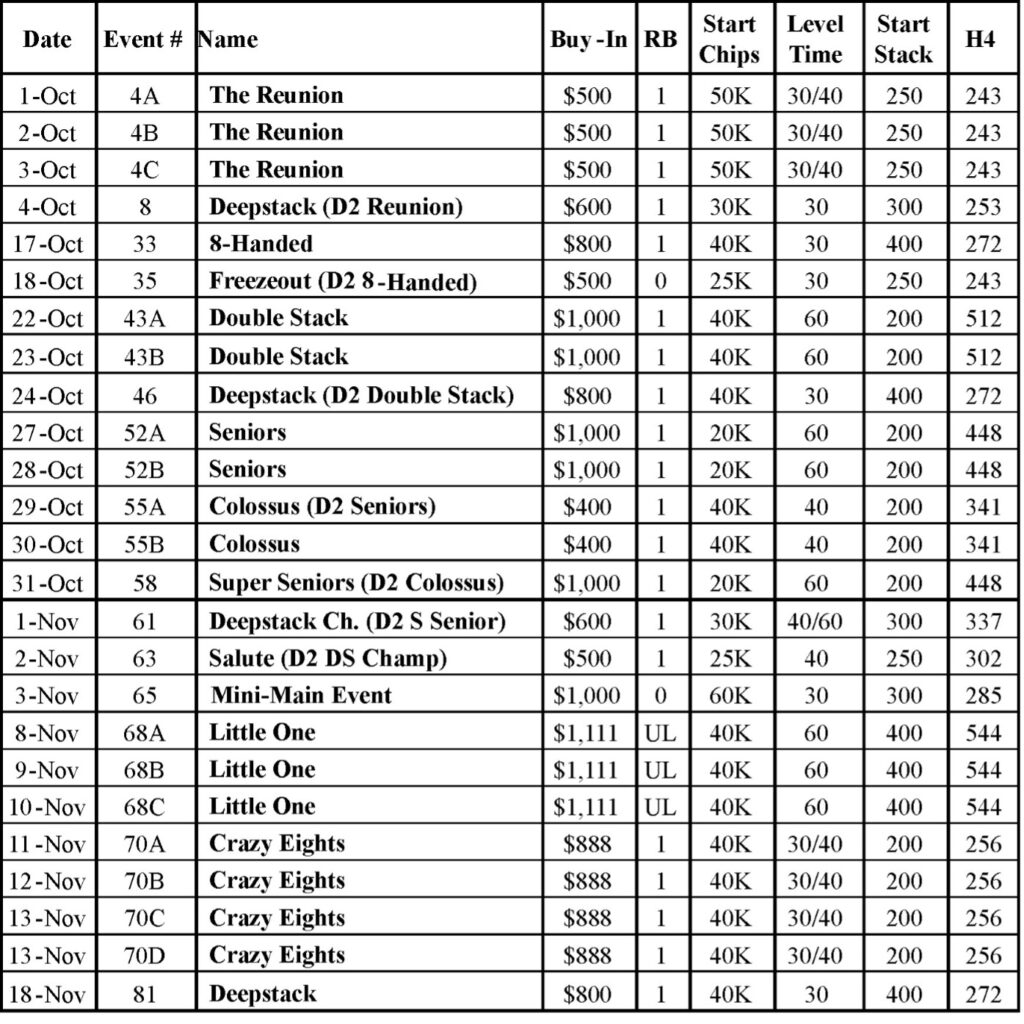“You realize how many times lightning has to strike in order for you to be sitting here?” — Mike Matusow
It’s been more than a year since the live WSOP at the Rio took a hiatus, but the best tournament series in the world is returning to Las Vegas on Sept. 30 with 88 events. I can barely wait.
As much as I might like to play every high-roller event on the schedule, I’m not a backed professional and have a limited bankroll. (I expect that you have similar constraints.) So which events should I play?

Since I am fairly skilled, I prefer events that provide the most bang for the buck. To me, that means the tournaments with the most play for the least cost.
The BOT tournament quality metric
My standard tournament quality metric has been Blind-Off Time (BOT). This is the number of hands (or hours) we expect to see before being blinded off, folding every hand. A higher BOT indicates a slower tournament, which favors the skilled player and indicates a high-quality event.
I calculate BOT by entering the tournament’s blind/ante structure into a custom spreadsheet. Then I assume an average number of players per table and an average number of dealt hands per hour (HPH). Most 2021 events are 9-handed, compared to 10-handed for most of 2019’s day ones. Consequently, I’m using an average dealing rate of 32 HPH for my 2021 model, compared to 30 HPH for 2019. I use 34 HPH for 8-handed events.
The H5 tournament quality metric
Although the BOT metric is fairly intuitive, it doesn’t mimic the way we actually play a tournament. Furthermore, BOT is difficult to calculate and it emphasizes the early levels of the tourney. Perhaps we can do better.
I analyzed the cashing times for 22 selected No-Limit Hold’em events in 2019 and discovered that they correlate well with what I call the “H5” time, as shown in Figure 1. The H5 time is the point in the tourney when our starting stack size becomes five big blinds.
For example, if we begin with 20,000 chips, the H5 point occurs when the big blind becomes 4,000 chips. This can be expressed in levels, playing time or hands dealt.

The H5 time does a reasonable job of predicting the cashing time of these WSOP events, but we can use the cashing time equation if we want more accuracy. The key feature here is that a higher H5 means a longer cashing time, which implies a higher-quality tourney.
A big advantage of the H5 metric is that it can be calculated without any fancy math. We simply look at the structure sheet to find when our starting stack drops to five big blinds. Then we can convert this to H5 (hands) by multiplying by our HPH estimate. I generally use H5 (hands) rather than H5 (hours) since it allows easy comparison among tourneys with different dealing rates, such as auto-shuffled, shorthanded, or online tourneys. Knowing H5 (levels) can be useful when we’re actually playing, too.
This metric also considers blinds levels all the way to the bubble, many more than BOT does. I think this makes the H5 metric somewhat better than BOT as a quality metric.
The WSOP on a budget
Suppose I have just enough bankroll to finance an entry to the $10,000 Main Event. As alluring as playing the Main Event would be, I prefer to mitigate my huge tournament variance by playing a large number of lower-fee tournaments, perhaps also against a weaker field.
Fifty of the 2021 events are No-Limit Hold’em events (my specialty). Some of these are turbos, heads-up, shootouts, restricted, or high-roller events. This leaves 18 economy events of $1,111 or less. Six of these have multiple day-ones, providing up to 10 additional starts. This is more than enough opportunity for most of us.

Figure 2 summarizes the key parameters of these tourneys, listed in entry fee order. I also include the $1,500 events and the Main Event for easy reference.
2021 structures
These 2021 events all use small variations of the same blinds/ante structure. Most use the structure I call B1, which begins with 100/100/100 antes and blinds. Some events make a small change to level 20, keeping the orbit cost unchanged. Structure B2 is the same as B1 with slight changes to levels 15, 19, and 20 without changing the orbit cost. These structures are all essentially the same.
The Colossus uses structure A1, which is similar to B1, except that it skips the first level. The A2 structure, used only for the Reunion is the same as A1, except that it skips two additional levels. It would be much easier if the WSOP uses a single structure for every NLH event, adjusting the starting stack and level duration to accommodate various entry fee and marketing considerations.
These 2021 BOT values are about 15% lower than they were for the 2019 events, mostly because the 2021 structures have been modified. For example, the 2021 B1 structure added a BBA to level 1, deleted level 2, and changed level 3 from 100/300/300 to 200/300/300. This makes the 2021 structure more than one level faster than the 2019 structure.
Cheap seats
There are six events with entry fees of $600 or less, with three additional day-ones. The best of these is the Colossus. It is the cheapest event on the calendar and it has the best H5 for any event less than $1,000. It is clearly the best tourney for the money on this list, significantly better than the Reunion, which costs $100 more and provides much less play.
The Deepstack Championship structure is as good as the Colossus, but it costs 50% more. Nevertheless, it is my second favorite cheap-seat event.
Economy seats
There are 12 events with entry fees between $800 and $1,111, which include eight additional day-ones. Three of these events are restricted (the Ladies, Seniors, and Super Seniors events).
Six economy events are significantly faster than the Colossus for at least double the cost. Indeed, the $1,000 No-Limit Hold’em Freezeout is faster than all of the cheap-seat events, and is easily the worst event on this list.
But, the three restricted events and the Tag Team event each have excellent structures. And the Little One for One Drop has the best structure in this price range. This is because we can double our starting stack for a small $111 add-on.
Premium seats
There are five $1,500 events with three additional day-ones. Three of them provide no better value than many of the cheaper events. The Monster Stack is better than any cheaper event, except for the Little One for One Drop. The Millionaire Maker is slightly better than the Seniors or Ladies events, but at a 50% higher cost.
The Plan
My plan includes only events costing $1,111 or less. (Of course, winning the Reunion might change my plans.) Figure 3 shows my plan for the 2021 WSOP.

A $10,000 budget would take me through the October 31 Super Seniors event, but it’s unlikely I’ll play everything on my list, even though I live in Las Vegas. For example, if I make day two in Event 4A, I wouldn’t play 4B or 4C. I also wouldn’t enter Event #8 unless I can do so with at least 50 big blinds (which is my late entry and rebuy criterion). Of course, cashing would replenish my budget so that I can work my way further down the schedule.
Summary
The 2021 WSOP at the Rio promises to be another exciting series. The structures are excellent and there are many affordable choices. If you’re on a very tight budget, I recommend the Colossus or the Deepstack Championship. With a little larger budget, you can try one of the restricted events or the Little One for One Drop.
See you in October.
Steve Selbrede is the author of seven poker books, The Statistics of Poker, Beat the Donks, Donkey Poker Volume 1: Preflop, Donkey Poker Volume 2: Postflop, Donkey Poker Volume 3: Hand Reading, Tournament Poker for the Rest of Us and Lectures on Poker, Vol. 1: Small Stack Tournament Strategy.


